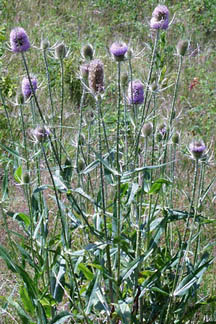Invasive Species Spotlight: Teasel | |
|---|---|
| June 9, 2008 | |
|
The Illinois Cooperative Agricultural Pest Survey (CAPS) program is a joint effort between several state and federal agencies, including the Illinois Natural History Survey, Illinois Department of Agriculture, and USDA-APHIS-PPQ. Its primary objective is to safeguard our nation’s food and environmental security from exotic, invasive pests that threaten our production and ecological systems. The program achieves this by conducting pest-detection surveys, collecting information, and managing data on invasive insects, plants, and pathogens in Illinois.  Common teasel. A new feature in the newsletter will be an “Invasive Species Spotlight” that provides information on different invasive pests. First in the line up is teasel.Two teasel species are found in Illinois: common teasel and cut-leaved teasel. Both are described as biennial herbaceous. The first year, the plant grows as a basal rosette; the second year, both species flower and can grow up to 6 feet tall. Common teasel blooms from June through October (pink or purple flowers), while cut-leaved teasel usually blooms July through September (white flowers). The unique flowers make teasel readily identifiable when blooming. Native to Europe, these plants were originally used in the 1700s for combing wool. Due to their unique flower structure, they are now popular in dried flower arrangements and horticultural plantings. However, these plants are persistent invaders of natural areas. They are commonly found along roadsides but can also be found in disturbed areas. These teasel species are aggressive exotic plants that produce large numbers of seeds and can easily colonize areas, displacing native plants. Management of teasel includes removing existing plants to prevent seed dispersion. Plants can be dug up and disposed of or several herbicides can be effective if plants are sprayed before flower initiation. For more information, stop by the Illinois CAPS blog (www.illinoiscapsprogram.blogspot.com).Kelly Estes | |
| Author: | Phil Nixon |
